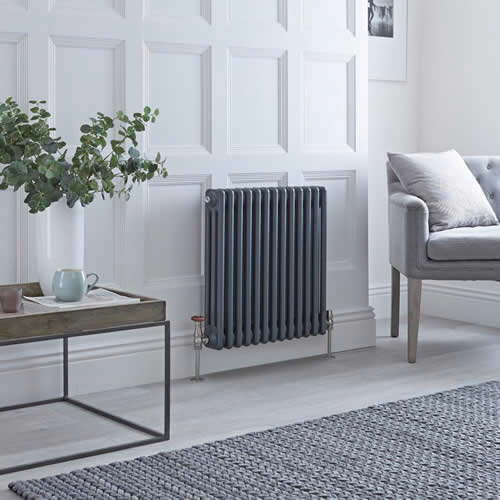
Take a moment and scan the room you are in. Your eyes will likely trace the lines of the walls, settle on the furniture, appraise the lighting, and perhaps admire a piece of art. Now, find the radiator. For decades, this object has been the subject of a collective interior design conspiracy, an item to be hidden behind ornate covers, tucked beneath windowsills, or painted into functional invisibility. We have been trained to see it as a purely utilitarian appliance, a metallic box that exists for the sole purpose of dispensing warmth, and nothing more.
But this perception is dissolving. A quiet revolution has been taking place in the world of interior architecture, and it is centred on this very appliance. The radiator is no longer the awkward guest at the design party; it is fast becoming the guest of honour. This is not merely a story about heat; it is a story about form, material, and the sophisticated transformation of a household necessity into a powerful statement of personal style.
The journey from a crude iron heating element to a sculptural centrepiece is a fascinating one. It maps our own technological progress, our changing relationship with our living spaces, and our growing desire to infuse every corner of our homes with intention and beauty. We are moving beyond the era of the passive, bland “white box” and entering a new age where the source of our comfort is also a source of aesthetic pleasure. This article explores that evolution—examining how new forms, intelligent materials, and a fundamental rethink of placement have elevated the humble radiator into the architectural soul of the modern home.
From Function to Form: Tracing the Aesthetic Lineage
The story of the modern radiator is a story of rediscovery. The earliest iterations, born in the Victorian era, were behemoths of cast iron. They were unapologetically industrial, celebrated for their brute-force ability to tame the cold, damp climates of the industrial north. They were heavy, ornate, and possessed a kind of steampunk grandeur, but they were never considered “designed” in the modern sense. They were engines for living. As the 20th century progressed and minimalism took hold, these intricate beasts were replaced by the efficiency of the pressed-steel panel radiator.1 This was the triumph of function over form—cheap to produce, quick to heat, and easy to install. It was this model that became ubiquitous, the white rectangle that we so actively try to ignore.
The aesthetic narrative, however, began to shift dramatically when designers and architects started to look back, not with nostalgia, but with a desire to blend history with modern engineering. This revival championed forms like Column Radiators, which masterfully bridge the gap between historical elegance and superior heat output. These units, with their distinctive repeating vertical tubes, suddenly offered a sculptural, textured quality that the flat, sterile panel wholly lacked. They became a bridge between the industrial integrity of the past and the design-conscious present. This single act of looking back proved that a heat source could also be a centrepiece.
This renaissance did not stop with simple reproduction. It cracked open the door for true innovation. Designers began to ask: If a radiator can be beautiful, what else can it be? This question led to an explosion of creativity. We saw the advent of flat-panelled vertical units that resembled abstract art, mirrored finishes that played with light and space, and bold, architectural shapes that refused to be ignored. The radiator was no longer just in the room; it was part of the room’s core design language.2 This shift in thinking is crucial. It moved the radiator from the “appliances” budget to the “fixtures and fittings” budget, placing it alongside lighting and flooring as a key element of an interior’s success.
The Material Matrix: What Your Radiator is Really Made Of
To understand the modern radiator, one must look beyond its shape and delve into its very substance. The material it is crafted from is not a trivial choice; it dictates everything from the feel of the heat to its environmental footprint and its responsiveness to your lifestyle.
Cast Iron: The Thermal Battery
The original. A radiator forged from cast iron is a heavyweight in every sense of the word. Its primary characteristic is its immense thermal mass. This means it takes a long time to heat up, but crucially, it takes an exceptionally long time to cool down. This creates a unique kindof warmth. It is not the sharp, immediate heat of a fan heater, but a deep, penetrating, radiant warmth that soaks into the fabric of the building and the objects in the room. It feels like the lingering heat of a hearth. This “slow-release” comfort makes it ideal for large, draughty spaces and period properties where consistent, background warmth is essential. Aesthetically, it remains the undisputed king of heritage and industrial-chic designs, offering ornate, traditional scrolling or bare, brutalist sections.
Steel: The Versatile Canvas
Mild steel is the workhorse of the modern radiator world. It is strong, malleable, and relatively inexpensive, making it the perfect canvas for designers. The vast majority of designer radiators, from sleek towel rails to complex geometric sculptures, are crafted from steel. It heats up significantly faster than cast iron, offering a more responsive heating experience that pairs well with modern, programmable thermostats. You can come home to a cold house and have it comfortably warm in under an hour. Its surface is perfect for a varietyOf finishes, from classic white powder-coating to polished chrome, brushed anthracite, and even bold, custom colours. It is the chameleon of the radiator world, able to adapt to any design scheme.
Aluminium: The Eco-Champion
Aluminium is the new-guard material, and its properties are perfectly suited for the 21st-century home.3 It is a superlative conductor of heat—in fact, it’s about five times more conductive than steel. This means aluminium radiators respond almost instantaneously. The moment the hot water enters, the surface begins to radiate warmth. This rapid response time makes them incredibly efficient, as they require less hot water from the boiler to reach their target temperature.4 They are also remarkably lightweight, making them easy to install and the perfect choice for internal stud walls that cannot bear the weight of cast iron. Furthermore, aluminium is often recycled and is itself highly recyclable, giving it a powerful green credential that resonates with eco-conscious homeowners.
The Great Upheaval: Why Vertical Radiators Conquered the Wall
For a century, the rule was simple: the radiator lives under the window. This was a practical decision from a bygone era, designed to use the coldest spot in the room to create a convection current of warm air, counteracting the draught from single-glazed sashes. Today, that rule is obsolete. Double- and triple-glazing have all but eliminated that draught, freeing the radiator from its traditional prison.
This freedom, combined with the changing landscape of our homes, sparked the vertical revolution. Modern architecture favours open-plan living, kitchens filled with cabinetry, and vast expanses of floor-to-ceiling glass.6 In these spaces, the low-level “dead space” under a window simply no longer exists. The only available real estate is the wall itself. The vertical radiator was born from this necessity.
However, it quickly evolved from a space-saving solution to a dramatic design statement. A tall, slender radiator does something remarkable to a room: it draws the eye upward, visually enhancing the ceiling height and creating a senses of grandeur and openness. It ceases to be an appliance and becomes a pillar, a sculpture, or a deliberate vertical accent. Placed strategically, it can frame a doorway, add symmetry to a feature wall, or tuck neatly into a narrow slice of wall in a kitchen or bathroom that would otherwise be useless. This vertical orientation completely reframes our relationship with heat. It’s no longer a background hum; it’s a focal point, proving that practicality and high design can, and should, coexist.
Beyond the Pipes: The Rise of the Smart, Sustainable Radiator
The final piece of the radiator’s transformation is invisible: intelligence. The most beautifully designed radiator is still inefficient if it is heating an empty house. The future, which is rapidly becoming the present, is about precision, control, and sustainability.
This is where the electric radiator, once relegated to chilly conservatories, has truly come of age. Modern electric radiators are not the expensive, clunky storage heaters of the past.7 They are sophisticated appliances filled with “dry-thermal” elements or thermodynamic fluids that are 100% efficient at the point of use—every watt of electricity drawn is converted directly into heat.8 They are the perfect solution for home extensions, loft conversions, or garden offices where extending the central heating system’s pipework would be prohibitively expensive and disruptive.
More importantly, both electric and traditional “wet” system radiators are now part of the connected home. Smart thermostatic radiator valves (TRVs) allow for granular, room-by-room, minute-by-minute control from a smartphone.9 You can create heating “zones,” warming your bedroom just before you wake up and your living room just before you return from work, while leaving the rest of the house at a low, background temperature. This zonal approach is the cornerstone of modern heating efficiency. When this smart technology is paired with a high-performance material like aluminium, the result is a heating system that is not only beautiful but incredibly responsive, cost-effective, and environmentally conscious. The most sustainable energy, after all, is the energy you do not waste.
Conclusion: The Warm Heart of the Designed Home
The radiator has undergone a profound metamorphosis. It has crawled out from under the curtains and stood up, demanding to be seen. It has shed its utilitarian skin to reveal an object of material beauty and sophisticated engineering. It is no longer a passive box, but an active participant in our daily lives—a smart device we can control from our palms, a sculptural element that defines our aesthetic, and a critical component of a sustainable, efficient home.
From the enduring, radiant warmth of cast iron to the lightning-fast, eco-friendly response of aluminium; from the horizontal workhorse to the towering vertical sculpture; the modern radiator is a testament to the idea that even the most functional items in our homes can be sources of joy and inspiration.
The next time you walk into a room, new or old, do not let the radiator be an afterthought. Let it be the anchor. Challenge the “white box” mentality and see this appliance for what it has become: a powerful fusion of art and science, a focal point of design, and the true, warm heart of the modern architectural space.

